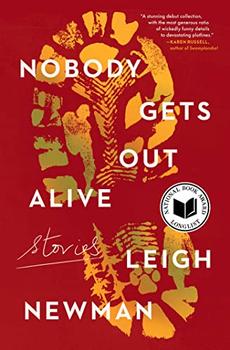Book Club Discussion Questions
In a book club? Subscribe to our Book Club Newsletter!
Please be aware that this discussion guide will contain spoilers!
- In "Howl Palace," the first story in Nobody Gets Out Alive, the protagonist carefully prepares her home to be viewed by prospective buyers, even though "Anybody who buys a house on Diamond Lake brings in a backhoe and razes the place to rubble" (page 1). In your opinion, what is she attempting to show the family who will purchase Howl Palace?
- Consider what we are told about Dutch's wolf room. Where did the wolf pelts come from? Why do you think they are so important to Dutch? What might this room and its contents represent for her?
- In "High Jinks," Katrina's and Jamie's families are "twin families and each other's only real family, since their other families, with grandparents, lived thousands of miles away, in the Lower 48." What role does isolation play in this story and in the other stories? In what ways does it make the families' friendships stronger, and in what ways does it strain them?
- Reread the final two sentences of "High Jinks," on page 51. Why do you think the author might have chosen to end this story with these lines? Discuss.
- In "Nobody Gets Out Alive," Janice says to Carter, "You know the sad thing about weak people? They fall in love with strong ones, thinking they'll get stronger... . But it's the weakness that rubs off" (page 74). Consider the four main characters in this story. Who do you think she is she talking about? Who are the weak characters, and who are the strong? In your opinion, what do weakness and strength mean to Janice, and what do they mean in the context of this story?
- 6There are five protagonists in "Alcan, an Oral History": Janice, Maggie, Laurel, Danielle, and Maureen. Each is en route to a destination. Do any of them make it? Pick a character to discuss. What sets her off course?
- 7. In her letter to Maggie, Danielle writes about Alaska, "Nothing here is fixed, nothing is any better" (page 133). Why does she feel the need to say this to Maggie?
- In Bobby's memory of his childhood prank at JCPenny in "Slide and Glide," his amusement turned to fear when his mother, who had surprised him by joining him in the clothing rack, failed to respond to his sister's frightened calls. He recalls his mother smiling at him, "her face white, smooth, almost serene," and remaining silent (page 174). Why did her reaction make young Bobby fearful? What do you think his mother was experiencing in this moment? In your opinion, why might this memory have returned to Bobby during the family's trip to the cabin?
- In "Valley of the Moon," Jamie and Becca respond very differently to the traumatic event in Montreal. How do Jaime's and Becca's respective relationships to their mother shift after the incident? What accounts for the difference?
- What are some ways the idea of motherhood surfaces in the story "Our Family Fortune-Teller"? The narrator notes that, of all her clients, "[a mother] is there to find out who she is and who she might have been and who she almost was" (page 216). In other words, a mother is in pursuit of the truth about herself. Consider the world of the story and the mother figures it depicts. Do you notice this pattern, too? Did it come up in other stories?
- Turn to the description of Mr. Carmichael's mother in "An Extravaganza in Two Acts" (pages 274-75). Name some similarities between Hazel's story and that of Mr. Carmichael's mother. What becomes of their abilities, and why? How do their outcomes differ? How is artistic talent, particularly when possessed by women, significant to the story?
- On the second-to-last page of the final story, we learn the origin of the properties along the shore of Diamond Lake, one of which would eventually become Howl Palace, the home from the very first story. This is one of many subtle interconnections woven throughout Newman's collection. How does reading "An Extravaganza in Two Acts" enrich your experience of "Howl Palace"? Why do you think the author chose to end the collection in this way?
Enhance Your Book Club
- Read and discuss Leigh Newman's memoir, Still Points North, about her upbringing in Alaska.
- To learn more about Alaskan wilderness and urban life, consider reading John McPhee's narrative nonfiction book on the subject, Coming into the Country.
- For more work by Alaskan women writers, check out Chia-Chia Lin's novel The Unpassing and Eowyn Ivey's novels The Snow Child and Last Days in Hunting Camp.
Unless otherwise stated, this discussion guide is reprinted with the permission of Scribner.
Any page references refer to a USA edition of the book, usually the trade paperback version, and may vary in other editions.
